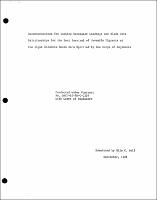Please use this identifier to cite or link to this item:
https://hdl.handle.net/11681/27309Full metadata record
| DC Field | Value | Language |
|---|---|---|
| dc.contributor.author | Bell, Milo C. | - |
| dc.date.accessioned | 2018-06-13T17:52:08Z | - |
| dc.date.available | 2018-06-13T17:52:08Z | - |
| dc.date.issued | 1981-09 | - |
| dc.identifier.uri | http://hdl.handle.net/11681/27309 | - |
| dc.description | Technical Report | - |
| dc.description.abstract | A review of the data on fish passage through turbines shows that a good approximation of success levels can be based on the efficiency of an operating unit at the time when the small fish pass through that unit. To aid in determining the levels of efficiency of fish passage at the various flows used for power generation at various head levels, a series of graphic presentations is included. These show the relationship of efficiency based on the output (in horsepower) of the units and the range of operating heads for the various projects. | en_US |
| dc.format.extent | 19 pages/1.134 Mb | - |
| dc.language.iso | en | en_US |
| dc.publisher | United States. Army. Corps of Engineers. Portland District. | en_US |
| dc.relation | http://acwc.sdp.sirsi.net/client/search/asset/1050410 | - |
| dc.rights | Approved for Public Release; Distribution is Unlimited | - |
| dc.source | This Digital Resource was created from scans of the Print Resource | - |
| dc.subject | Hydroelectric power plants--Environmental aspects--Columbia River Watershed | en_US |
| dc.subject | Fishes--Effect of dams on--Columbia River Watershed | en_US |
| dc.subject | Fishes--Migration--Columbia River Watershed | en_US |
| dc.title | Recommendations for turbine generator loadings and blade gate relationships for the best survival of juvenile migrants at the eight Columbia basin dams operated by the Corp of Engineers | en_US |
| dc.type | Report | en_US |
| Appears in Collections: | Technical Reports | |
Files in This Item:
| File | Description | Size | Format | |
|---|---|---|---|---|
| Turbine generator loadings and blade gate relationships.pdf | 1.16 MB | Adobe PDF |  View/Open |